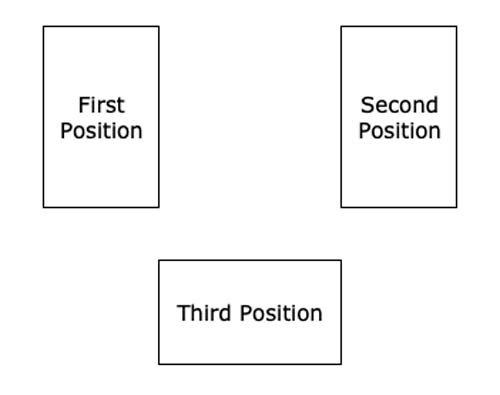NLP Perceptual Positions
Shifting perspectives
The ability to see things from the point of view of another is a key skill in understanding people, and is important to communication processes in relationships, negotiation and interviewing, as well as to healthy boundaries and self-concept.
Often, it is useful to assess an event or outcome from several different perspectives: from our own perspective, from the perspective of another person and from the perspective of an independent observer. Perceptual positions provide a balanced approach to thinking about an event or outcome. In situations where there is little or no understanding or progress, they can provide a way of developing new understandings and creating new choices.
This type of exercise is useful in gathering information and often a new choice in the world becomes available without a deliberate intervention. Because of the systemic nature of humans’ lives, often a person in a situation cannot see answers that a person standing outside can. So by moving between different perceptual positions, one can see a problem in new ways or with greater detachment, and thus gather more information and develop new choices of response.
Taking different perceptual positions enables you to step out of what you are currently experiencing and gather new information by seeing things from a different perspective. You can also check out how your own words and behaviour may be impacting on other people, and how they may be feeling about you and your actions. This new knowledge will help you make the necessary changes in your behaviour and thus achieve desired outcomes.
By deliberately training yourself in moving between perceptual positions you can develop a new choice of responses.
The three perceptual positions are:
First Position: seeing, hearing and feeling the situation through your own eyes, ears and feelings. You think in terms of what is important to you, what you want to achieve.
Second Position: stepping into the shoes of the other person and experiencing (seeing, hearing and feeling) the situation as if you were them. You think in terms of how this situation would appear or be interpreted by the other person.
Third Position: standing back from a situation and experiencing it as if you were a detached observer. In your mind, you are able to see and hear yourself and the other person, as if you were a third person. You think in terms of what opinion, observations or advice would someone offer who is not involved. By disconnecting you from the emotions involved, this position helps you take an objective view of both behaviours and look for opportunities to respond differently in order to achieve a different and more positive outcome.
All three positions are of equal importance and it is useful to consciously or unconsciously cycle through these positions as we go about our daily activities.
Sometimes we get stuck in one of these positions.
Someone who lives his/her life in first position tends to focus on his/her own needs rather than the needs of others – a “self-centred” attitude.
Someone, who lives their life primarily in second position, is more conscious of other people at the expense of their own needs; they can be unassertive and burn themselves out be failing to look after themselves.
Someone who lives in third position can seem rather aloof, a disinterested observer of life, logical rather than emotional, failing to participate.

Another approach to perceptual positions involves looking at a situation from the viewpoint of several different people involved. For example, a strike looks very different from the viewpoint of a CEO, a worker, a customer and a supplier. A problem is almost always harder to solve if a person only appreciates their own viewpoint and not those of others involved.
Exercise
Take up each position consecutively and ask these questions: -

Remember that when you are in Second Position, the ‘I’ refers to the person whom you are experiencing, and they/them refers to the person in First Position, i.e. you!
Timeline
Perceptual positions can also be considered from three or more positions in time:




